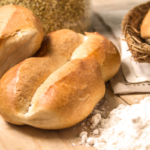If you are a passionate baker, then you will always be on the lookout for new foods to try making at home. One amazing food that is becoming more and more widely enjoyed around the world is simit – a popular type of bread from Turkey!
It’s an unusual food that will really put your baking skills to the test and so, more bakers in the US want a good simit recipe to try out at home.

Well, here it is – an authentic recipe for street-food simit from Turkey! Check out the recipe below and give it a go!
What Is Simit?
First, let us define what simit actually is and what makes it so special.
As it’s still a relatively new thing in the US, it’s understandable that you may not entirely know what simit is. So, here’s everything you need to know about simit before you start baking!
Simit is a type of bread that originates from Turkey.
It’s known by a few other names including bokeh, gevrek, and koulori. It’s also known as the ‘Turkish bagel’ due to its circular shape.
The circular shape is not the only interesting thing about simit; it is made of twisted dough so it features a hypnotizing pattern all the way around the ring.
It’s also larger than a bagel with a much wider center hole, and is encrusted with sesame seeds for a crunchy texture. Simit also has a much more savory taste thanks to the use of seeds in its recipe, giving it a unique nutty taste.
Simit is usually enjoyed plain and served with tea as a light breakfast bread. However, it can also be enjoyed with fruit preserves or cheese.
In other areas of the Middle East, simit is sometimes enjoyed with boiled eggs, yogurt, buttermilk, and duggah (a mixture of herbs used as a condiment).
All across Turkey, simit is sold by street vendors on trolleys or trays carried on the head. Because of this, simit is often viewed by tourists as a classic street food to try out during their visit to Turkey.
This has played into how simit is slowly crossing the ocean and becoming a popular alternative food in the US. Tourists visiting Turkey have liked the bread so much that they want to try making it at home!
So, if you want to try making this delicious bread at home, here is a great recipe for you to follow!
Ingredients And Equipment
Every baker and chef knows that before you start making your dish, you need to gather and prepare all your ingredients and equipment.
After all, the last thing you want is to start making your simit bread only to find out you don’t have all the ingredients you need – it will completely ruin the recipe!
So, follow the list below to make sure you have everything you need before you start making your own simit.
Simit Ingredients
- 2 ½ Cups of Flour
- ¾ Cup of Water
- 1 Tablespoon of Sugar
- 1 Teaspoon of Salt
- 1 Teaspoon of Instant Yeast (or ¼ Teaspoon of Active Dry Yeast)
Simit Topping Ingredients
- ¼ Cup of Grape Molasses (also known as uzum pekmezi, 100ml to be exact is needed)
- ¼ Cup of Water
- 1 Cup of Roasted Sesame Seeds
Alternative Ingredients For Dietary Restrictions
While traditional simit is vegan-friendly as it uses no animal products, it is still not suitable for everyone.
If you have dietary restrictions that prevent you from eating gluten, then it may feel that it’s safer for you to just avoid simit altogether – but it is possible to make a gluten-free version of simit!
All you need to do is swap out the flour. There are versions of gluten-free flour out there and any type is suitable for simit. So, it’s super easy to make a gluten-free version of simit yourself so you don’t have to miss out on this delicious Turkish bread.
Alternative Ingredients For Grape Molasses
Traditional simit is made using grape molasses for its coating. This sticky coating is what helps the sesame seeds stick to the bread’s surface and also creates a gorgeous golden finish to the bread while it bakes.
However, grape molasses is not just used to help the simit bread look great. It also brings a particular flavor to the simit bread too – so if you want an authentic taste of simit bread, you need to use grape molasses for the coating!
The thing is that grape molasses can be difficult to source. If you need an alternative, then you have two options open to you – fruit syrups and molasses, or honey.
Fruit syrups and molasses are the best alternative ingredient to use instead of grape molasses.
Pomegranate molasses is the best and they may be easier for you to get a hold of but it’s worth noting that they do leave a more sour flavor to your bread.
Sweeten up the molasses by adding a spoonful of sugar to the sauce before you start dipping in your dough.
Honey is the easiest alternative to grape molasses to use but it also gives your simit bread a very sweet flavor.
As simit is supposed to be a pretty savory type of bread, this will conflict with the rest of the recipe – but if you plan on eating your simit with sweet things like fruity preserves or honey, then this won’t affect you as much.
Equipment
- 2 Large Mixing Bowl
- 1 Wooden Spoon
- 1 Baking Tray
- 1 Plate
- Parchment Paper
- Plastic Wrap

How To Make Simit (Turkish Street Bread)
Now that you have everything ready, you can start making your own simit. Follow the below recipe and good luck!
Step 1: Making The Dough
To begin making simit you need to first start with making the dough.
Take your large mixing bowl and add in the water. The water should be lukewarm (around 90 degrees Fahrenheit) when you add in the sugar, salt, and yeast. Use your wooden spoon to mix in the ingredients until they dissolve.
Next, add in the flour and stir to make your dough.
Simit dough is pretty dry and not very smooth, especially compared to other types of dough you are more used to working with.
It definitely should not be sticky or wet after plenty of stirring. If your simit dough is too wet, then add a small amount of flour and stir in until you get the right texture.
Once your dough is ready, it’s time to start kneading.
Simit dough only needs to be kneaded for around 6 minutes until it’s fairly soft but not so smooth. Remember to dust your flat working surface with some flour to help prevent the dough from sticking to the surface while you knead.
After kneading, divide the dough into 4 equal parts and roll them with your hands until you get 4 cylinders each around 12cm (or 4.7 inches) in length.
Pop your dough strips onto a prepared baking tray with parchment paper, cover them with plastic wrap, and let the dough rest for around 10 minutes.
Step 2: Shaping The Dough
The next step is much easier to do if you concentrate on one dough strip at a time.
Once the 10 minutes are up, take a dough strip and divide it into 2 equal parts. These strips should be rolled until they are each around a foot in length.
Place them side to side and roll one end on either side in the opposite direction so they become entwined. Then, wrap the braid in a circle and pinch the ends together to close it.
To help seamlessly blend the ends together, rest the close of the simit against the working surface and use one hand to lift the simit up (keeping the close against the working surface).
Slip your other hand inside the circle and roll the close so the ends join together.
Once that’s done, you will have completed your simit. Place it back on the prepared baking tray. Repeat the steps above to make the rest of your simit rings.
Step 3: Coating The Simit
Before you throw your simit rings into the oven to bake, they first need to be coated.
Take a clean mixing bowl, and pour in your grape molasses. On a separate clean plate, pour your roasted sesame seeds.
Then, dip each simit ring into the molasses (flipping to cover both sides) and then dip them into the sesame seeds (again, remember to dip both sides of the simit rings).
Your simit rings should be completely covered in molasses and sesame seeds before being placed back onto the baking tray.
Step 4: Final Proofing And Shaping The Simit
Cover your simit rings once more with plastic wrap and let them sit at room temperature for 30 minutes. This will allow them to rise and proof for the final time – however, this will cause them to grow a little out of shape.
Once the proofing is done, remove the plastic and reshape your simit rings. Using your hands, just pull and stretch the dough to make the simit rings larger and more even.
This will make it easier for the insides of your simit to cook evenly while they bake.
Step 5: Baking The Simit
Your simit is now ready for baking so it’s time to preheat your oven. Preheat the oven to 450 degrees Fahrenheit (or 230 degrees Celsius) and let your simit bake for 10 minutes.
After these 10 minutes, reduce the temperature of your oven to 400 degrees Fahrenheit (or 200 degrees Celsius). Let your simit bake for a further 8 to 10 minutes.
Once your simit rings are golden brown, they are ready to be removed from the oven and allowed to cool for a few minutes. Your simit rings will be ready to eat when they’ve cooled so, enjoy!
How To Serve Simit
Simit is a savory type of bread with a unique crunchy texture and nutty flavor. They can be enjoyed on their own without any additives or sides – but if you want to shake things up, then here are some great ways to serve and eat simit!
- Make simit sandwiches by slicing the simit in half and adding fillings. Popular choices to complement the savory flavor of simit includes tomatoes, cucumbers, olives, and cheese (usually feta or mozzarella).
- Break your simit bread and dip it into some honey or yogurt as a quick and easy breakfast meal.
- Slice up your simit and spread fruit preservatives or honey (kind of like toast) for a daytime sweet treat.
- Try eating your simit plain while drinking traditional Turkish tea for a truly authentic Turkish breakfast (for more Turkish recipes, see here for a delicious Turkish Pide recipe).
Ultimately, simit can be enjoyed at any time of the day because it’s a savory, crunchy type of bread. It works great as a light breakfast, as a fun type of bread to swap out for your usual bagel, and to serve on the table during dinner!

How To Make Simit Pizza
Simit is traditionally made and eaten in rings of braided bread, coated with sesame seeds – but this isn’t the only way to use simit bread to make some delicious snacks!
A popular trend over the years has been to use simit bread to make simit pizza – but how?
Making simit pizza is actually very easy. Pick up the recipe after Step 1 so you have the dough prepared. Instead of making rings out of the dough, you are going to divide each portion into 2 and flatten them into oval-shaped pizza bases.
Other simit pizza recipes may ask you to shape the dough in a more traditional circular shape – but oval shapes mean you can fit more pizzas on a single baking tray!
Coat your simit pizzas and leave them to proof in the exact same ways as the recipe above. Once they are ready for the oven, remember to add on your pizza toppings first. Some great simit pizza toppings include:
- Mozzarella cheese
- Tomatoes
- Olives
- Traditional spicy Turkish sausage called ‘sucuk’
- Red onions
- Red bell peppers
- Chilis or jalapenos
These make for a great lunchtime snack or make lots of different varieties to serve at parties and gatherings!
Final Thoughts
So, that’s how you can make your very own simit bread at home!
Making simit bread is a great way to bring a taste of Turkey home no matter where you are. Although they may look complex, simit bread is actually pretty easy to make as long as you have the right ingredients.
So, if you have your heart set on making your own simit at home, follow the recipe above! You can even try an alternative simit recipe and make simit-based pizza for something totally new! Good luck!
- How To Reheat A Cheesesteak - November 5, 2023
- What Are Three Must Have Kitchen Knives? - September 22, 2023
- How To Protect Edges Of Pie Crust - June 15, 2023








